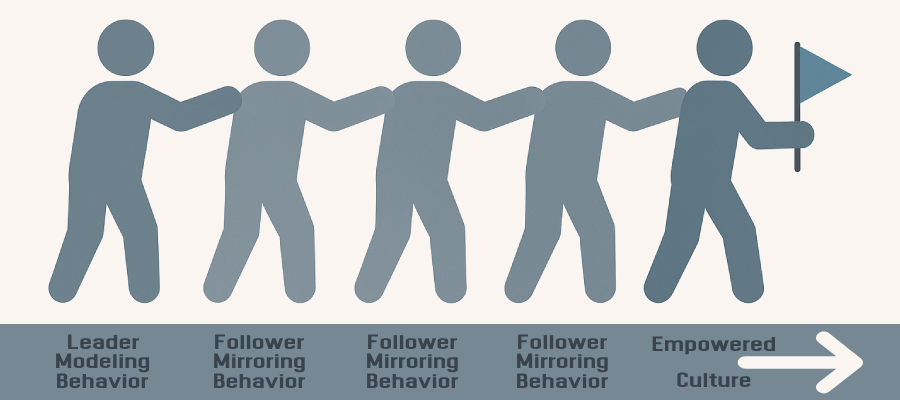The Construction and Destruction of Culture
The question, “If everyone else was doing it, would you?” has long been used to challenge conformity. Yet, the reality is more sobering. In many situations—whether in organizations, schools, communities, or even entire nations—the answer is, in fact, probably. People often do what the group does, not because it is correct or rational, but because it feels safer than standing apart.
This is not an indictment of weakness but a reflection of deep-seated emotional and psychological mechanisms that shape human behavior. Leadership must acknowledge these mechanisms, not dismiss them. In fact, in some instances, leaders can use these mechanisms to their advantage. To build a resilient organizational culture and to safeguard the integrity of our broader social fabric, we must understand the forces of conformity and compliance and learn how to channel them toward strategic outcomes.
The Psychological Foundations: Why Conformity Happens
From Solomon Asch’s conformity experiments to Stanley Milgram’s obedience studies, the empirical record is clear: individuals are easily swayed by group pressure and authority figures, even when it conflicts with logic, evidence, or moral conviction. The driving factor is not ignorance; it is emotional tension. The fear of being ostracized, ridiculed, or simply “different” is a powerful motivator. Remember that emotion drives bias. Bias drives belief. Belief drives behavior. And behavior determines our outcomes.
The 3B Behavior Modification Model helps us understand why conformity can become a default position. People conform because they emotionally anchor to the belief that social belonging is more critical than accuracy. Over time, that belief becomes an unexamined bias: standing apart is synonymous with danger. The outcome? Blind acceptance of ideas, practices, or behaviors simply because they appear normalized within a group.
Of course, leaders have a choice. They can either lead this phenomenon or become victims of it. Leading it requires modeling, repetition, reinforcement, and emotional reassurance. Of course, this requires knowing what outcomes you are shooting for. On the other hand, becoming a victim of it requires you to do nothing. Simply hope someone else takes the lead or hope it will all work out in the end.
Culture Is Not Declared—It Is Demonstrated
Organizational culture does not emerge from slogans or vision statements. Those help reinforce, but it is born of observable, repeatable behavior. Like integrity, culture is “what we do when no one is watching,” and more often than not, that behavior is shaped by what people perceive to be acceptable and rewarded. The first few followers in any cultural initiative are critical. As Derek Sivers famously pointed out, a leader without followers is just someone taking a walk. But once someone joins, and then another, the behavior gains momentum—not because of logic, but because of emotional reassurance: “I’m not alone.”
The question is never whether behavior will be modeled, because it will be. The real question is who will model it, and what behaviors will take root. When consistently demonstrated, vision-driven actions, growth-oriented habits, and team-focused conduct spread organically and strengthen the organization. However, if dysfunction, entitlement, or self-interest get modeled (and tolerated), they quietly metastasize, carried forward by passive compliance, fear of standing apart, and the opportunism of those who recognize how this misalignment can be exploited for personal gain.
When strategic leadership models behavior congruent with the organizational vision and gives others time and space to observe and practice it, true culture begins to take root. This is to say that telling people what the culture should be is not enough. Followers must see it, engage with it, and emotionally experience its legitimacy and power. But this means that leaders must create the conditions for this experience: clarity of expectation, space for modeling, reinforcement and reward of aligned behaviors, and strategic identification of early adopters who can carry the message through action, empowering them to act boldly, not cautiously.
When Compliance Works Against You
Every organization (and every society) is vulnerable to cultural subversion. Compliance and conformity are neutral mechanisms; they will support whatever appears dominant or normalized, regardless of its alignment with strategic goals or moral values. If a rogue influence gains visibility and early adoption, especially by charismatic individuals or those with positional authority, it can redirect organizational culture entirely.
This is not theoretical. In geopolitical terms, Reflexive Control operates precisely this way. It influences perceptions, introduces emotionally resonant narratives, and lets the target population draw the “logical” but manipulated conclusions. In organizational settings, subversive influences may not be foreign governments but internal personalities whose values and agendas are misaligned with the stated vision. If their behaviors become accepted, either out of indifference or fear of confrontation, the culture shifts. We are living this in the United States, just not like most might think.
Thus, leadership must be both proactive and vigilant. This is something you typically won’t see in a leadership meme, but developing culture is not merely about setting a direction; it’s about protecting that direction from hijack. That requires consistent modeling, transparent systems of accountability, and the courage to confront misalignment resolutely, especially when it is coming from insiders.
Recommendations for Countering Destructive Conformity and Building Constructive Culture
- Model Behavior Relentlessly: Leaders must live the behaviors they wish to see. Nothing undermines culture faster than hypocrisy.
- Empower First Followers: Identify and support early adopters who genuinely believe in the vision. Provide them with proximity, reinforcement, and visibility.
- Create Repetition Through Ritual: Cultural behaviors become ingrained through consistent, patterned reinforcement. Design meetings, feedback loops, and communications that reflect core values in action, not in word alone.
- Break Bias: Challenge default assumptions through Contrastive Inquiry and cognitive dysfluency. Invite teams to examine the opposite of what they assume, and then walk them through the logic of why alignment matters.
- Recognize Emotional Drivers: Address the emotional fear of non-conformity directly. Make space for people to feel psychologically empowered while embracing new norms.
- Guard the Gate: Culture is always vulnerable to deviation. Leaders must not only model behavior but also strategically exclude, confront, or realign influences that compromise cultural integrity.
- Extend the Time Horizon: Transformation is not instant. People need time to see behaviors modeled repeatedly before internalizing them. This time should not be rushed.
Cultural Decay and Collective Responsibility
What is true for organizations is also true for nations. The same forces of conformity, compliance, and emotional anchoring operate within national culture. When society rewards outrage, incentivizes victimhood, or normalizes emotional fragility, the resulting culture reflects those values, not because they were rationally chosen but because they became familiar, safe, and, more importantly, unchallenged. Remember that familiarity is often powerful than truth.
Just as organizational culture can be subverted, so too can national ethos. However, the antidote is the same: courageous modeling, clarity of vision, support for early adopters of reason, and reinforcement of emotionally and strategically sound behaviors. In both arenas, if you want the culture to change, you must be bold enough to become the demonstration of that change, not by lecture, but by behavior.
Reasoned Leadership Over Blind Compliance
Conformity is not inherently wrong. But conformity that occurs without reason, reflection, or alignment is dangerous. It breeds fragility, groupthink, and cultural decay. Leadership that fosters culture must do more than set expectations. It must model, support, protect, and strategically reinforce the vision until it becomes normalized. That process is not passive; it is deliberate, emotional, and deeply human.
Do not merely hope for or expect the culture you want. Build it. Show it. Repeat it. Live it. And more importantly, protect it. Because one thing is for certain: if you don’t, someone else will build a different culture for you. Culture is always under construction, and leadership that fails to guard it invites infiltration.
Which brings us to my final warning on the topic. Be very mindful of what you’re reinforcing and always question the things that “sound about right.” Plenty of things sound great until they are realized.
- “Inclusivity” sounds noble—until it’s used to justify lowering standards, silencing dissent, or protecting dysfunction.
- “Respect” sounds virtuous—until it’s redefined to mean never challenging bad ideas.
- “Unity” sounds ideal—until it becomes a weapon to suppress legitimate dissent.
- “Support” sounds compassionate—until it enables mediocrity and excuses failure.
- “Well-being” sounds caring—until it becomes the excuse for avoiding responsibility and discomfort.
- “Psychological Safety” sounds responsible—until it’s weaponized to shield fragile egos, discourage truth, and prevent necessary confrontation.
The list goes on, but the point is that the greatest threats to culture often arrive wrapped in language that sounds reasonable, familiar, or even virtuous. The point is that sounding about right and being accurate are not the same. Subversive ideas often mimic good intentions while quietly undermining values, expectations, and outcomes. Without vigilance, empowerment, knowledge, and rigorous questioning via Contrastive Inquiry, even well-meaning efforts can become the delivery mechanism for cultural decay.
Let’s See It Action
Again, do not merely hope for the culture you want. Build it. Show it. Repeat it. Reward it. Live it. But also protect it. What did the leader of the study do with the nonconformist? If outcomes matter, then we should consider doing something similar with those who do not want to participate in the culture we are trying to create. Of course, that doesn’t mean everyone must think the same or agree on every point. It also doesn’t mean that everyone must follow every rule. After all, individuality and dissenting opinions are essential to innovation and growth. However, there is a massive difference between constructive disagreement and cultural erosion.
The vision (destination/ultimate success/calculated future) is the key. If we have a similar outcome in mind, you are welcome to shake things up. However, a cohesive vision cannot survive in an environment where its foundations are constantly undermined (read that again). That is the distinction. Organizational culture must be inclusive of individuals, but not permissive of attitudes or behaviors that contradict the direction or vision. Protecting the culture means being clear: participation in the pursuit of the vision is not optional. Almost everything else is a discussion.
Critical Reflection Exercise
Now imagine this dynamic not just in a workplace, but in a jury room, a classroom, a boardroom, a national debate stage, or even at home. What happens when the first confident voice is misinformed, uneducated, biased, manipulative, or bound by Epistemic Rigidity? And what happens when those who follow are equally unprepared and driven more by emotion than understanding? Culture isn’t limited to organizations; it takes shape wherever people gather and behaviors are reinforced. So ask yourself: in any group you’re part of, are you leading with clarity and conviction, or simply echoing the noise? What does that look like down the road?




